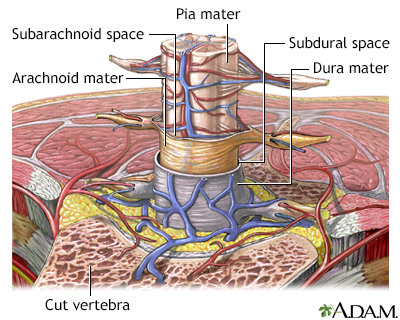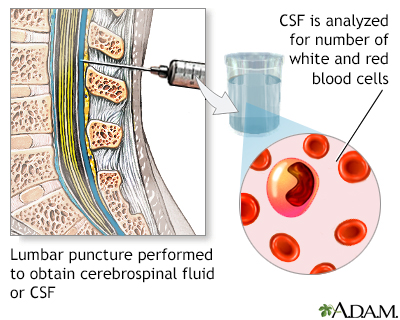Staphylococcal meningitis
 Print-Friendly
Print-Friendly
Meningitis is an infection of the membranes covering the brain and spinal cord. This covering is called the meninges.
Bacteria are one type of germ that may cause meningitis. The staphylococcal bacteria are one type of bacteria that cause meningitis.
Staphylococcal meningitis is caused by staphylococcus bacteria. When it is caused by Staphylococcus aureus or Staphylococcus epidermidis bacteria, it usually develops as a complication of surgery or as an infection that spreads through the blood from another site.
Risk factors include:
- Infections of heart valves
- Past infection of the brain
- Past meningitis due to spinal fluid shunts
- Recent brain surgery
- The presence of a spinal fluid shunt
- Trauma
- Bloodstream infection with Staphylococcus aureus
I Would Like to Learn About:
Causes
Staphylococcal meningitis is caused by staphylococcus bacteria. When it is caused by Staphylococcus aureus or Staphylococcus epidermidis bacteria, it usually develops as a complication of surgery or as an infection that spreads through the blood from another site.
Risk factors include:
- Infections of heart valves
- Past infection of the brain
- Past meningitis due to spinal fluid shunts
- Recent brain surgery
- The presence of a spinal fluid shunt
- Trauma
- Bloodstream infection with Staphylococcus aureus
Symptoms
Symptoms may come on quickly, and include:
- Fever and chills
- Mental status changes
- Nausea and vomiting
- Sensitivity to light (photophobia)
- Severe headache
- Stiff neck
Other symptoms that can occur with this disease:
- Agitation
- Bulging fontanelles in infants
- Decreased alertness
- Poor feeding or irritability in children
- Rapid breathing
- Unusual posture, with the head and neck arched backwards (opisthotonos)
Exams and Tests
The health care provider will perform a physical exam. Questions will focus on symptoms and risk factors.
If the doctor thinks meningitis is possible, a lumbar puncture (spinal tap) is done to remove a sample of spinal fluid for testing. If you have a spinal fluid shunt, the sample may be taken from this instead.
Tests may include:
- Blood culture
- Chest x-ray
- CT scan of the head
- Gram stain or other special stains, and culture of the spinal fluid
Treatment
Antibiotics will be started as soon as possible. Vancomycin is the first choice for suspected staphylococcal meningitis. Nafcillin is used when tests show that the bacteria are sensitive to this antibiotic.
Often, treatment will include a search for, and removal of, possible sources of bacteria in the body. These include shunts or artificial heart valves.
Outlook (Prognosis)
Early treatment improves the outcome. However, some people do not survive. Young children and adults over age 50 have the highest risk for death.
Staphylococcal meningitis often improves more quickly, with fewer complications, if the source of the infection is removed. The source may include shunts, hardware in joints, or artificial heart valves.
Possible Complications
Long-term complications may include:
- Brain damage
- Buildup of fluid between the skull and brain (subdural effusion)
- Buildup of fluid inside the skull that leads to brain swelling (hydrocephalus)
- Hearing loss
- Seizures
- Staph infection in another area of the body
When to Contact a Medical Professional
Call 911 or the local emergency number or go to an emergency room if you suspect meningitis in a young child who has the following symptoms:
- Feeding problems
- High-pitched cry
- Irritability
- Persistent, unexplained fever
Meningitis can quickly become a life-threatening illness.
Prevention
In high-risk people, taking antibiotics before diagnostic or surgical procedures may help reduce the risk. Discuss this with your doctor.
Related Information
| MeningitisShock |
References
Centers for Disease Control and Prevention website. Meningitis. About bacterial meningitis. www.cdc.gov/meningitis/about/bacterial-meningitis.html. Updated January 9, 2024. Accessed June 17, 2024.
Nath A. Meningitis: bacterial, viral, and other. In: Goldman L, Schafer AI, eds. Goldman-Cecil Medicine. 26th ed. Philadelphia, PA: Elsevier; 2020:chap 384.
Hasbun R, Van de Beek D, Brouwer MC, Tunkel AR. Acute meningitis. In: Bennett JE, Dolin R, Blaser MJ, eds. Mandell, Douglas, and Bennett's Principles and Practice of Infectious Diseases. 9th ed. Philadelphia, PA: Elsevier; 2020:chap 87.
















